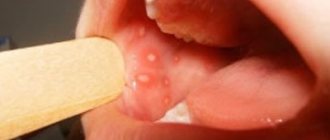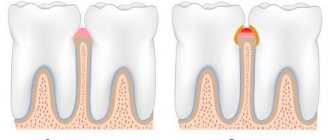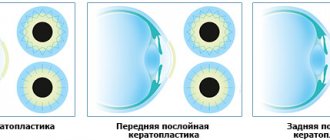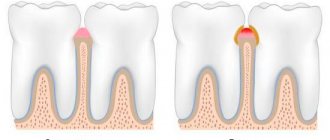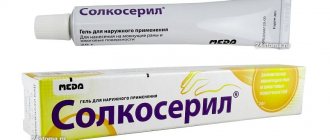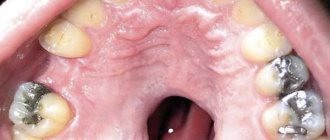Gingivitis is an inflammation of the gum tissue. This is the initial and most common form of gum disease in general. If left untreated, gingivitis can progress to periodontitis, which is a destructive form of periodontal disease.
Gingivitis is associated with the long-term effects of plaque deposits on the teeth. Dental plaque is a sticky substance made up of bacteria, desquamated epithelium and food debris, which always accumulates in areas of the teeth that are difficult to clean naturally. This is also the main cause of caries.
Periodontitis is an inflammation and is based on infection of the pockets between the tooth and the gum, which destroys the tissues that support the teeth - the gums, ligaments and teeth (in the alveolar bone).
If plaque is not removed in a timely manner, it turns into a hard deposit that forms at the base of the tooth. Plaque and tartar irritate and cause inflammation of the gums. Actively reproducing bacteria and toxins, which are the “waste” of their vital activity, are the cause of the rapid progression of gum disease.
The following are factors that increase the risk of developing the disease:
- Poor oral hygiene
- Pregnancy – hormonal changes affect gum sensitivity
- Diabetes
- Rough and uneven teeth
- Use of certain medications (phenytoin, bismuth)
- Use of contraceptives
Many people may experience some symptoms of gingivitis at different times in their lives - they often develop during puberty or adulthood due to hormonal changes (pregnancy, menopause). Different forms of gingivitis can persist or recur frequently, depending on the health of your teeth and gums.
Forms of gingivitis
- Catarrhal
- Ulcerative-necrotic
- Hypertrophic
Symptoms
- Externally - red and swollen gums
- Bleeding. Bleeding from the gums, even while brushing your teeth, is a sign of inflammation and a leading marker of periodontal disease.
- Bad breath. Food debris and bacteria can cause a bad taste in the mouth and persistent bad breath.
- Recession of gum tissue and tooth loss. As the disease progresses, the gum tissue decreases in volume and the supporting structure of the bone weakens.
- Abscesses. In the recesses of periodontal pockets between the gum and bone, dental deposits or food particles can become blocked, which causes acute purulent inflammation, the product of which is pus.
Acute catarrhal gingivitis
Acute catarrhal gingivitis is characterized by hyperemia and swelling of the gums, bleeding, pain, burning, chronic cyanosis, swelling, and loosening of the gums. Microbial plaque and hard dental deposits are responsible for the development of the disease. False pathological pockets and gingival stone are formed.
Characterized by the following
The gingival margin appears dirty gray, easily separated from the necrotic film. Acute pain, inability to eat. Bad breath, drooling. Regional lymph nodes are enlarged and painful. Body temperature up to 38-39. Lethargy, headache. Ulcers can spread to the oral mucosa.
Often, the presence of nausea in the first trimester does not allow proper oral care. When exposed to mild irritants, slight bleeding occurs on contact. Infection and the formation of purulent discharge are possible.
Treatment includes:
- Tartar removal
- Removing dental plaque from the tooth surface
- Polishing interdental spaces
- Correction of the proper condition of fillings
Classification of gingivitis according to intensity
- easy
- average
- heavy
The severity of the flow is determined3:
The degree of manifestation of general symptoms - weakness, fever, the presence of enlarged lymph nodes. Changes in condition are also reflected in blood tests. With a mild form, the temperature rises to 37.5°C, with a moderate form up to 38°C, with a severe form - up to 40°C.
Causes of ulcerative-necrotizing gingivitis
Ulcerative-necrotizing gingivitis is caused by fusobacteria and spirochetes. Most often it develops as a complication of catarrhal gingivitis, but it can also be an independent disease. It develops with poor oral hygiene against the background of a sharp decrease in immunity.
General factors
Common factors leading to the onset of the disease are stress, severe fatigue, infectious diseases, and hypothermia. More often the disease is observed in people with diseases of the digestive, endocrine and respiratory systems, heart and vascular diseases. Inadequate and unhealthy diet also increases the risk of developing ulcerative gingivitis. Taking certain medications can also lead to this disease.
Local factors
- Poor oral hygiene In this case, plaque accumulates on the teeth and stones form. With ulcerative necrotic gingivitis, not only ordinary microorganisms accumulate, but also spirochetes.
- Presence of other oral diseases Ulcerative gingivitis can occur as a complication of catarrhal gingivitis and herpetic stomatitis.
- Permanent gum injury For example, old fillings, crowns, dentures.
- Wisdom teeth eruption
- Multiple caries, as it increases the number of pathogens in the mouth
- Injury to the gums by the sharp edges of a carious cavity
- Oral surgery, including complex tooth extraction4
Treatment methods
With early diagnosis of the disease, gum health can be completely restored in 7 to 10 days. If gingivitis is not cured in a timely manner, long-term therapy will be required. Treatment methods depend on the type, severity of the pathology, causes of development, and age of the patient.
The complex of treatment measures includes:
- professional hygiene in dental clinics to clean teeth from deposits and stones;
- sanitation of the oral cavity to remove pathogenic microorganisms and their metabolic products;
- taking vitamins, antihistamines, antioxidants and other medications prescribed by a doctor;
- rinsing the mouth with solutions for antiseptics, relieving inflammation, accelerating tissue healing;
- surgical operations for hypertrophic, atrophic forms (excision or augmentation of gums);
- correction of hygiene procedures - replacing a hard brush with a soft one, consulting a dentist on proper oral care and nutrition.
For inflammatory gum disease, traditional medicine methods can and should be used. How to rinse your mouth with gingivitis? Doctors recommend using decoctions of chamomile, sage, calendula, and oak bark. If there are no herbs, you can prepare a soda solution. Rinse should be done after every meal.
Symptoms of necrotizing ulcerative gingivitis
The disease develops quickly and rapidly, its symptoms appear very clearly.5,6
- Severe pain that gets worse with the slightest touch or temperature changes
- Swelling of the gums
- Sensitivity of the mucous membrane
- Spontaneous bleeding gums
- The tongue is covered with a green, yellow coating
- Ulcers appear on the surface of the gums, covered with a gray coating.
- A sharply unpleasant, strong odor from the mouth that does not go away even when brushing your teeth
- Increased temperature, weakness, fever
- Necrosis of gum tissue
- Brushing teeth and eating food is difficult
- Lymph nodes are enlarged
- Aches, muscle pain
About tooth loss and how to avoid it
Last year, we, at Star Smile, released a cartoon video in which the heroine was thinking about what to do - either start bite treatment when she was young, or wait until all the teeth begin to decay. Here he is, by the way
The video received quite a lot of views and responses, many patients asked us to continue the topic of consequences - to show readers what inattention and carelessness when caring for teeth and gums can lead to. Therefore, we will continue to educate you and hope that our articles will help you contact doctors in a timely manner and avoid most of the problems that we write about.
Diagnosis of necrotizing ulcerative gingivitis
Diagnosis is made through the clinical manifestations of necrotizing ulcerative gingivitis.7,8
During the examination and questioning, the dentist identifies poor hygiene, bleeding gums, poor general condition and the absence of gum pockets (impaired attachment of the gum to the tooth). Be sure to take a panoramic photograph of all teeth to distinguish ulcerative gingivitis from periodontitis.
Additionally, bacteriological examination and the ELISA method can be carried out to confirm the diagnosis, determine the level of immunoglobulins and select appropriate treatment tactics.
It is important to distinguish ulcerative gingivitis from immunodeficiency conditions and blood diseases. For this purpose, if necessary, other tests may be prescribed.
Treatment of ulcerative-necrotizing gingivitis
At the first signs of illness, consult a doctor immediately!
Treatment of ulcerative gingivitis is always complex:
- Anesthesia of the oral cavity with sprays, gels, solutions. With ulcerative gingivitis, this stage is extremely important, since the pain is quite severe.
- Removing the inflammatory process. To do this, use gentle methods to remove plaque and tartar, and be sure to prescribe a course of rinsing with antiseptics for up to two weeks. It is during this visit to the doctor that material is taken for bacteriological examination.
- Removal of general symptoms - fever, headache, for this purpose analgesics and antipyretics are prescribed.
- Destroying pathogenic bacteria, for this purpose antibacterial or antimicrobial drugs are prescribed. (Important! Prescribed strictly by your doctor!)
- Vitamin therapy – to increase the body’s overall resistance to harmful factors.
- During treatment, it is recommended to eat non-irritating foods with sufficient calorie content and not to use spices.
- Treatment of general diseases together with a therapist, gastroenterologist and other specialists.
- After acute inflammation subsides, epithelializing drugs are prescribed (to stimulate tissue healing), professional hygiene, treatment of caries and its complications, removal of wisdom teeth, fillings and crowns (if necessary).
In case of ulcerative gingivitis, it is necessary to strictly follow all the doctor’s recommendations, otherwise complications may arise, and the disease may become chronic.
Removal of dental plaque is carried out under local anesthesia of the gums, using antiseptic drugs, only with the help of hand instruments.
Medicinal preparations containing metronidazole and chlorhexidine are applied to the ulcers, cleared of plaque with special enzymes. These drugs are designed to destroy pathogenic microorganisms, but they should be used only as prescribed by a doctor to avoid complications.
To relieve the inflammatory reaction, local applications with an NSAID solution can be applied for 10-15 minutes.
Acute gingivitis
The clinical picture of acute gingivitis gives classic signs of inflammation: swelling, redness, local increase in gum temperature, pain, disruption of normal gum function. Against this background, bleeding gums and even ulceration are observed. The general condition, with rare exceptions, is not impaired. Upon examination, inflammation of the gum tissue is determined, which extends either to the interdental gingival papillae (papillary gingivitis) or to the marginal gum (marginal gingivitis). The papillae, margin and attached gingiva may be affected (diffuse gingivitis). The intensity of inflammation varies from slight to pronounced. False periodontal pockets may occur due to swelling of the gums. The presence of deposits in the form of tartar or plaque is noted. In the acute form, the gum surface is smooth, shiny, bright red, swollen, and bleeds easily upon probing.
There are: Acute gingivitis caused by dental plaque. This group of gingivitis includes forms that can be caused by: microbial infections, systemic factors, medication, mechanical, thermal and chemical damage.
Gingivitis simplex acuta (simple acute gingivitis) Simple acute gingivitis is a form of gingivitis accompanied by a classic acute inflammatory reaction in response to physical and microbial damage.
Acute necrotizing ulcerative gingivitis This disease, also called Gingivitis acuta ulcerosa necroticans (Plauta-Vincet gingivitis), is characterized by pain, necrosis of the interdental gingival papillae and lymph node reaction. Progressive stages are characterized by the formation of craters with exposed alveolar bone. If left untreated, this disease can progress through necrotizing ulcerative gingivitis-periodontitis into ulcerative stomatitis, and then, in the form of Cancer oris or Noma, lead to death. If the disease is not stopped in time, an irreversible process of tissue loss occurs.
Gingivitis specifica acuta (acute specific gingivitis) Acute specific gingivitis includes specific infectious diseases of the gums as a result of exposure to tuberculosis bacteria, Candida albicans, Actinomyces israelii, Treponema pallidum.
Acute viral gingivitis Gingivitis is caused by herpes simplex viruses, as well as Herpes zoster and cytomegaly.
Gum abscess Gum abscess is an acute disease of the upper gums and leads to purulent melting of the interdental papillae and gingival tissue with the appearance of severe pain.
Complications and outcomes. Acute local gingivitis, when the cause that caused it is eliminated, can result in recovery. Acute generalized gingivitis, when the disease of which it is a complication is eliminated, also usually disappears. Chronically ongoing catarrhal, ulcerative and hypertrophic gingivitis is often a prestage of periodontitis.
Treatment of necrotizing ulcerative gingivitis with Tantum® Verde
Effective treatment of ulcerative gingivitis is possible with the use of anti-inflammatory drugs, which include Tantum® Verde . Benzidamine in its composition has a complex effect on the gums: reduces swelling, relieves inflammation, reduces pain and kills microbes on the surface and inside the affected tissues. Benzidamine penetrates well into the mucous membranes, which allows you to quickly cope with the disease. Tantum®Verde allows you to quickly relieve pain9, which is especially important in the treatment of necrotizing ulcerative gingivitis. From the first minute, Tantum® Verde has an anti-inflammatory and local anesthetic effect on the symptoms of gingivitis, such as a burning sensation, swelling and swelling of the gums. After the acute effects have subsided, it is possible to dissolve Tantum® Verde , since they have an anti-inflammatory effect within 9 minutes, which will allow you to quickly cure gingivitis.10, 11, 12
Prediction and prevention of necrotizing ulcerative gingivitis
If you consult a doctor in time and receive quality treatment, a full recovery is possible. Recurrence of the disease occurs with exacerbation of chronic diseases, a sharp decrease in immunity and poor oral hygiene.
If you postpone going to the doctor and do not follow the recommendations, ulcerative gingivitis can become chronic, which is less treatable, or develop into a more serious disease - periodontitis, which is accompanied by loss of bone tissue. Therefore, it is important to take a responsible approach to the treatment of this disease.
If a person has suffered ulcerative gingivitis, then a second visit is scheduled after 1-2 months, and then you should visit the dentist every six months.
Prevention of ulcerative gingivitis:
- Regular and adequate teeth cleaning
- Visit your dentist for examination and treatment (if necessary) twice a year
- Strengthening the immune system: you should pay attention to such simple things as physical exercise, proper nutrition, sleep patterns, hardening
- Stress management
- Treatment of existing chronic diseases: it is important to avoid exacerbations, otherwise relapses of the disease are inevitable
- Taking vitamins
Diagnostic methods
A visual examination by a dentist may be sufficient to assess the disease. If symptoms are severe, the doctor may refer the patient for an x-ray. This is necessary if infection of the pulp, periodontal and bone tissue is suspected.
In the presence of ulcers or chronic inflammation, a microbiological analysis is performed, which identifies the type of bacteria and their resistance to antibiotics. If a generalized form is diagnosed, then additional diagnostics are carried out by relevant specialists: ENT doctor, gastroenterologist, immunologist, and other specialists. The patient donates blood for general tests, sugar, HIV infection, syphilis.

